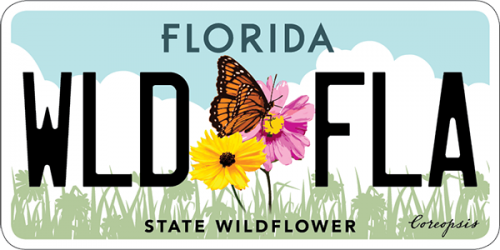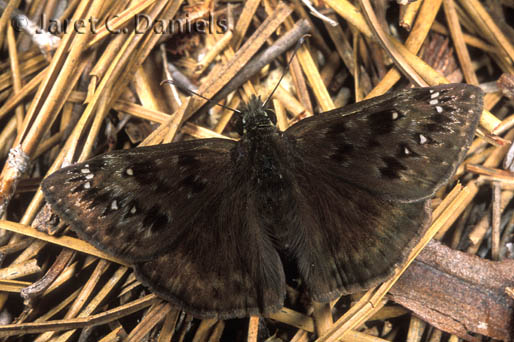- Family name: Hesperiidae/Skippers
- General description: Wings dark brown; forewing with small glassy spots including one at end of cell. Female more mottled in appearance, forewing with increased gray scaling and larger glassy spots. Hindwing below brown with faint pale spots along margin.
- Field Marks: Dark brown; forewing with small glassy spots including one at end of cell.
- Sexes: Appear different
- Wingspan: 35-50 mm
- Life Cycle: Egg: Green, laid singly on host leaves Mature larva: Blue-green with small white spots and a narrow dark dorsal stripe. Head dark brown with orange spots around margin. Chrysalis: Brown with fine darker brown markings.
- Number of Generations: Three or more per year
- Flight Season: All year
- Abundance: common
- Habitat: Woodland margins, swamps, forested yards, gardens
- Larval Host Plants: Various oaks (Quercus spp.) including Myrtle Oak (Quercus myrtifolia), Water Oak (Quercus nigra), Live Oak (Quercus virginiana), and Turkey Oak (Quercus laevis)
- Similar Species: No similar species
- Additional Information: Adults have a rapid, darting flight. Feed and perch with wings outstretched. Larvae construct individual leaf shelters on host. Larvae overwinter. Range is limited in New York, Michigan and South Dakota.
- Range in Florida
 The Florida Wildflowers & Butterflies projects at the Florida Museum are sponsored in part by the State of Florida and the Florida Wildflower Foundation, Inc.
The Florida Wildflowers & Butterflies projects at the Florida Museum are sponsored in part by the State of Florida and the Florida Wildflower Foundation, Inc.
